There are 12 types of lightning arresters. These are Electrolytic arresters, Rod Gap Arresters, Expulsion-type lightning arresters, Valve-type lightning arresters, Metal-Oxide Lightning arresters, Oxide film arresters, Sphere-Gap Arresters, Horn-Gap Arresters, Multiple gap arresters, Impulse protective gap, Thyrite lightning arrester, and Autovalve arrester.
Lightning is a natural phenomenon in which a shockwave hits a place or an object on earth causing potential damage. The shockwaves are very high-voltage impulses that try to find a short path to reach the ground. In this process, these shockwaves land on a taller and more conductive material causing it to face severe damage.
The power system infrastructure is not immune to these risks. There are various components of a power system that are susceptible to lightning. Lightning shockwaves may not only destroy them but the ripple effect of that damage could cause the entire power system to go unstable. Here comes the role of Lightning Arresters.
A lightning arrester is a type of protective equipment that is placed in the vicinity of a power system component. As the name says, a lightning arrester captures a lightning shockwave and provides it an alternative shorter path through itself thus protecting the costly and sensitive power system infrastructure.
Types of Lightning Arresters
There are various types of lightning surge arresters and the selection of one depends on various factors like application voltage, current bearing capacity, cost, size, reliability etc. These are:-
- Electrolytic arrester
- Rod Gap Arrester
- Expulsion-type lightning arrester
- Valve-type lightning arrester
- Metal-Oxide Lightning arrester
- Oxide film arrester
- Sphere-Gap Arrester
- Horn-Gap Arrester
- Multiple gap arrester
- Impulse protective gap
- Thyrite lightning arrester
- Autovalve arrester
Electrolytic Lightning Arresters
Electrolytic Arrester is an efficient and reliable lightning surge arrester. There are aluminum plates with a thin film of Aluminum Hydroxide deposited on them. These plates are immersed in an electrolyte. The plates provide a high resistance path for normal operating voltage below the critical voltage. If the critical voltage is breached, the plates provide a low resistance path for the passage of the electric current without affecting any critical component of the power systems.
The Electrolytic lightning Arrester provides a high resistance path to the ground for a normal range of operating voltage. However, during the lightning surge, the voltage is significantly high which causes the electrolytic arrester resistance to become low and the surge current passes through it. In this way, the power component stays protected.
Rod Gap Lightning Arresters
This is one of the simplest and most effective methods of surge diversion techniques. Transmission lines, for example, are supported by cross-arms that remain at earth potential. Thus, the high-voltage transmission line is attached to the support arms by using disc-type insulators whose one end is connected to the grounded cross-arms while the other supports the line.
During a lightning or even during a sudden spike in the line voltage, the dielectric breakdown of the surrounding air causes an arc to jump from the topmost disc to the bottom i.e, on the supporting cross-arms. This may cause a catastrophic accident at multiple levels.
Thus, a rod-gap arrester is used. In this technique, there are two rods separated by a small air gap. One rod is connected on the top of the topmost insulator i.e, with the line. While the other one is connected at the bottom at ground potential. Thus, any surge finds a short path through the rod gap and in this way protection of the component, as well as the entire power system, is assured.
Expulsion-type Lightning Arresters
Expulsion-type of lightning arresters are used in electrical systems operating at a voltage of 33kV or above. It is a better technique for arresting surge than the rod-gap arrester. This type of arrester is also called Protector Tube. It is similar to the rod-gap arrester except for the fact that these arresters have an additional gap in series with the rod gap (shown by AA’). This gap is enclosed within a fiber tube which is formed by two electrodes. The upper electrode is connected to the rod gap while the lower one is connected to the ground.
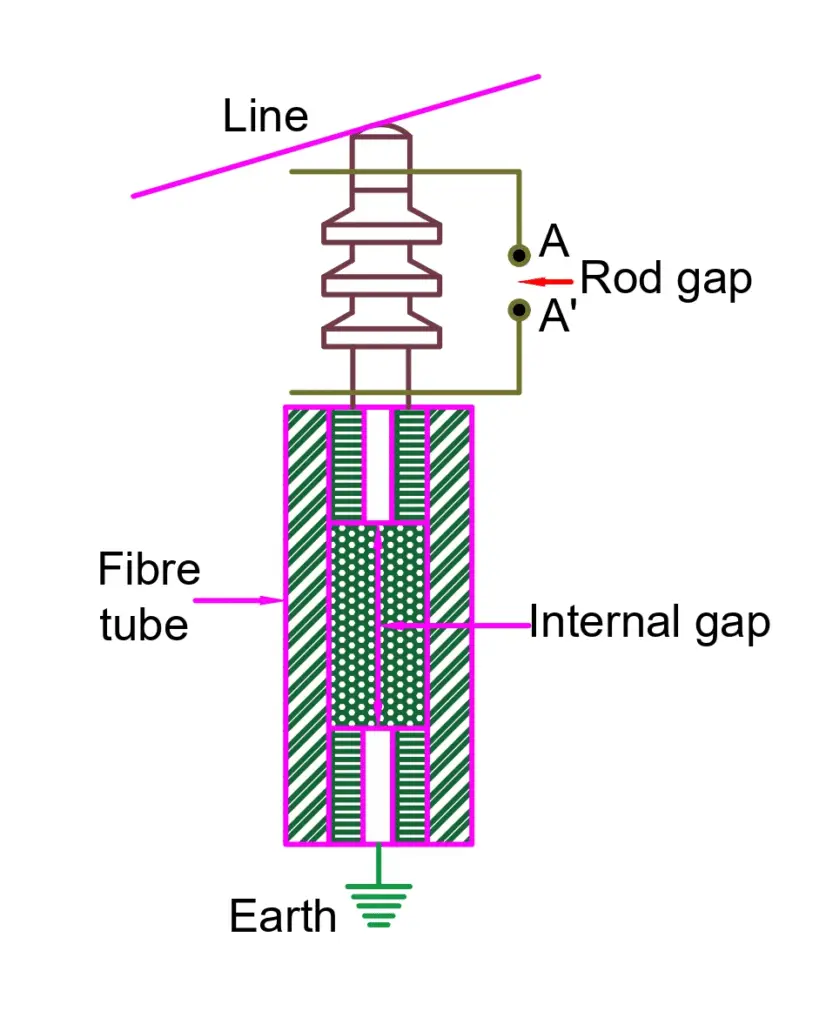
Valve-type Lightning Arresters
A valve-type lightning arrester is a non-linear surge suppressor or diverter. It is called “non-linear” as it has a non-linear resistance characteristic which causes it to regulate its current flow with respect to voltage.
A valve-type lightning arrester is a costly and efficient method of the surge arrester. It consists of spark gaps connected in series. Under normal operating conditions, the arrester remains inactive. But during the occurrence of a fault or lightning, a breakdown of the series gaps takes place and the non-linear resistance provides a low resistance path by regulating itself. This causes the surge current to flow through the path to the ground immediately and the power system component remains safe.
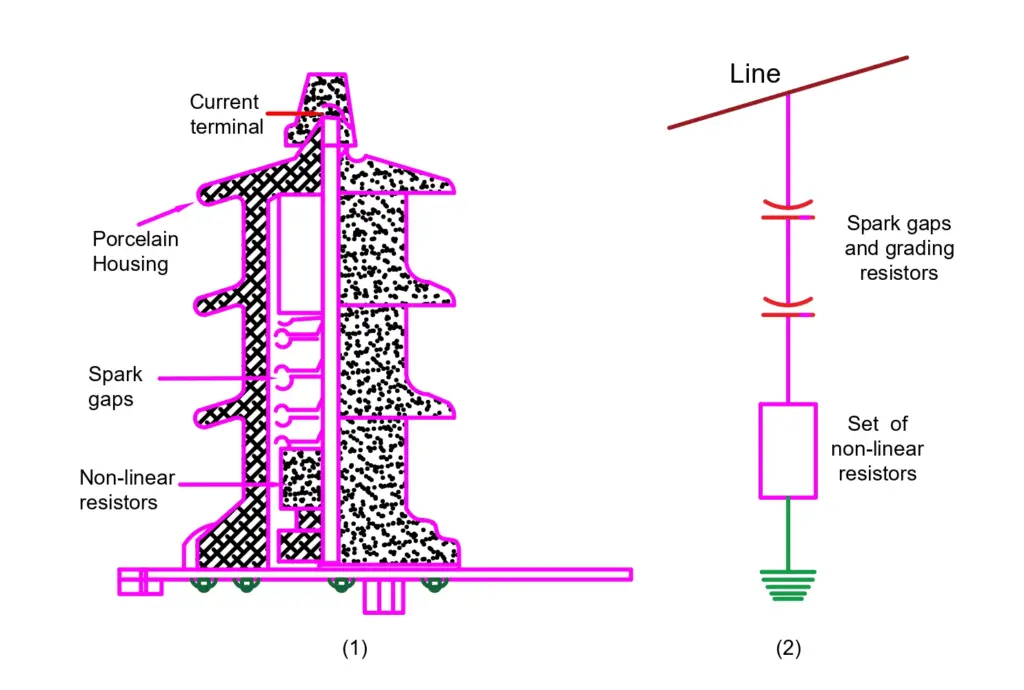
Metal-Oxide Lightning Arrester
Metal-Oxide lightning arresters contain zinc oxide (ZnO) as the metal-oxide resistor. Hence, it is also known as a Zinc Oxide diverter. Zinc Oxide is an N-type semiconductor material that is doped with some fine powder of insulating oxides. These powders are then compressed into a disc shape and enclosed in a porcelain casing which is filled with Nitrogen or Sulphur Hexa-Fluoride (SF6).
The boundaries of each ZnO disc act as a barrier that controls the flow of current during normal operating conditions. But during lightning or a high-voltage surge, these barriers break down and the material behaves as a conductor rather than an insulator. This allows the surge current to pass to the ground without affecting the other systems.
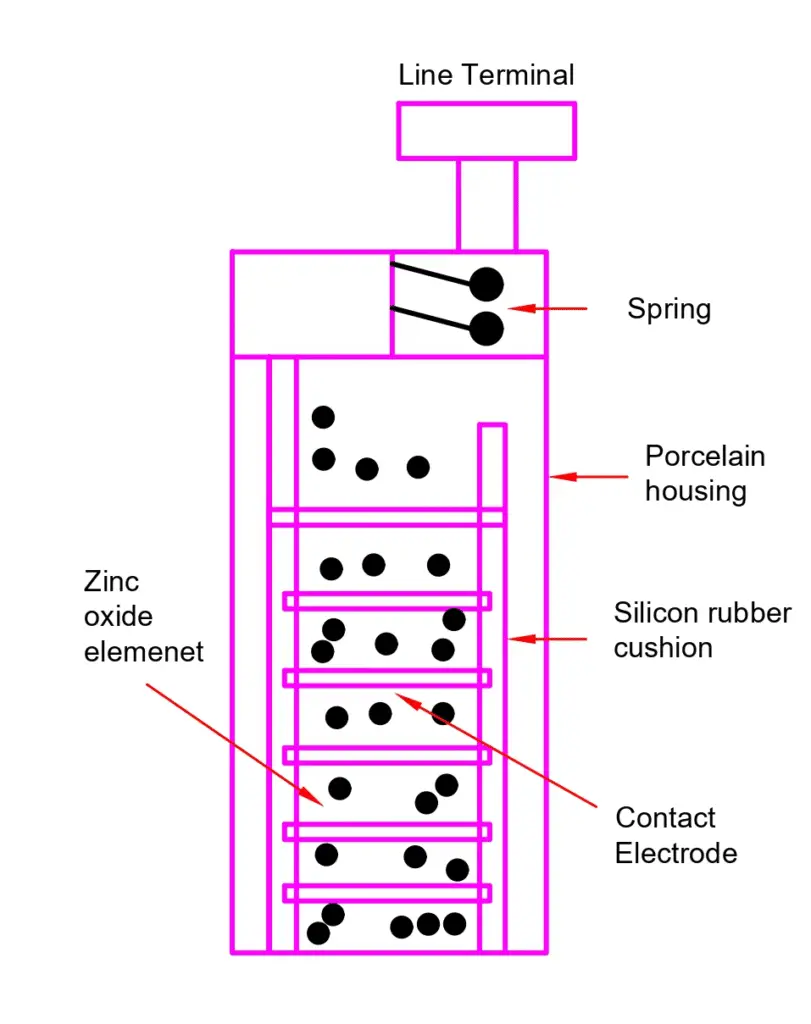
Oxide Film Arrester
Oxide film lightning arresters consist of lead peroxide pellets coated with litharge arranged in a column and enclosed in a tube. There are two such lead connections – The upper lead is connected to the line while the lower one is to the earth. There are a series of spark gaps through which an arc passes during the time of lightning or over-voltage surge.

Sphere Gap Arrester
In a sphere gap surge arrester, there are two spheres. One is connected to the line while the other one is connected to the ground. There is a very small air gap between the spheres. The gap is maintained appropriately so that it remains inactive during normal operation.
At the time of the surge, the arc jumps from the line-connected sphere to the ground-connected sphere. As a result, the air surrounding the arc heats up and this warm air tends to rise up thus carrying the arc upwards with itself. This causes the arc length to increase and the corresponding arc resistance also increases as resistance is directly proportional to the length of the conductor. This causes the arc to extinguish within moments.
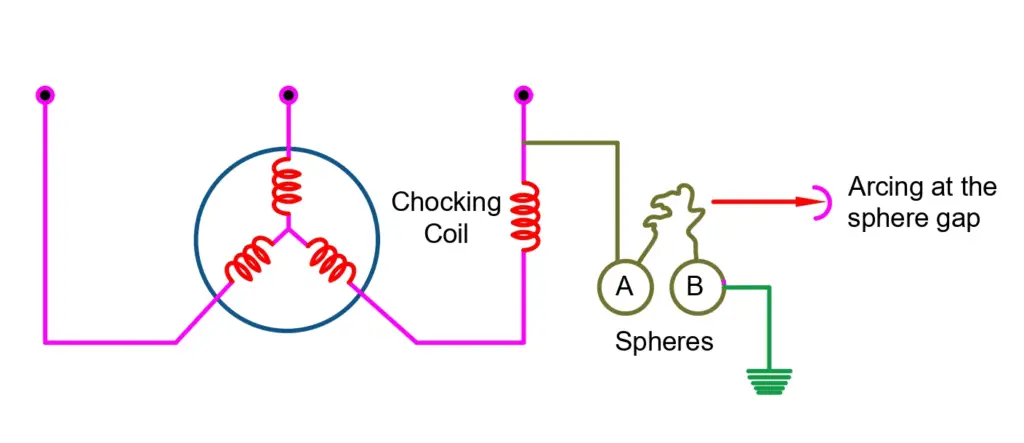
Horn-gap Arrester
Horn-gap-type lightning arresters have limited use due to their unreliability. It is used as backup or secondary protection with the main arrester. In a horn-gap arrester, two metallic plates are bent to form a horn shape. One of these plates is connected to the system to be protected while the other one is connected to the earth. There is a measured air gap between the two plates which acts as the insulating media.
The one connected to the system is connected in series with a resistance and inductance which limits the transients during normal operation. During the time of fault or lightning, the air gap insulation breaks down and allows an arc to jump. The shape of the bent horn-like metallic plates has a narrow gap at the base and a wider one at the top.
Thus, as the warm air around the arc pushes it up, the wider metal gap at the top causes the arc length to increase thus increasing its resistance and eventually the arc extinguishes. However, this method is unreliable as primary protection as it takes a longer time (2-3 seconds) to work appropriately.
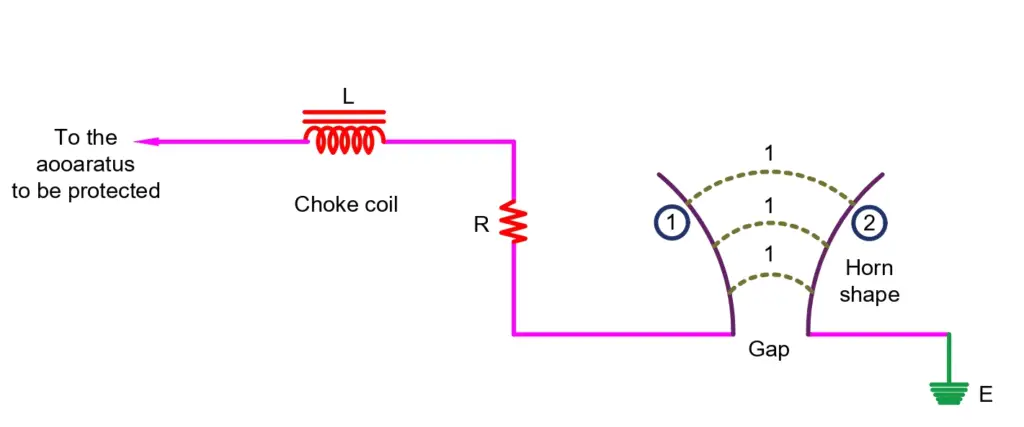
Multiple Gap Arrester
Multiple gap arrester as the name says consists of multiple gaps depending on the nature of over-voltage protection required. It consists of small insulated metal cylinders separated from each other by an air gap. The number of gaps depends on the system voltage.
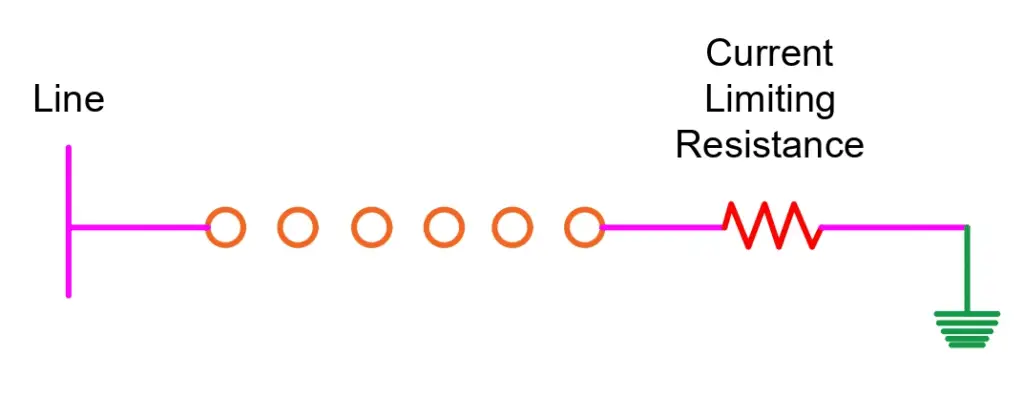
Impulse Protective Gap
An impulse protective gap type lightning arrester has a very small impulse ratio even less than unity. The impulse ratio of an insulator can be defined as the ratio of impulse peak voltage to the peak voltage. The gap consists of two sphere-horn electrodes S1 and S2. S1 is connected to the line while S2 is connected to an electrolytic arrester. An auxiliary needle E is placed between S1 and S2 and connected through a resistor R and capacitors C1 and C2.
During normal operation, the power frequency is low and thus the capacitive reactance of C1 and C2 is much higher compared to R (as Zc = 1/2f). But during a surge, the capacitive reactance decreases rapidly and thus the resistor R becomes dominant. The result is that practically the whole of the voltage is concentrated across the gap between E and S1.
The gap at once breaks down, and the rest of the gap between E and S2 immediately follows. In this way, the length of the gap halves at the time of a surge.
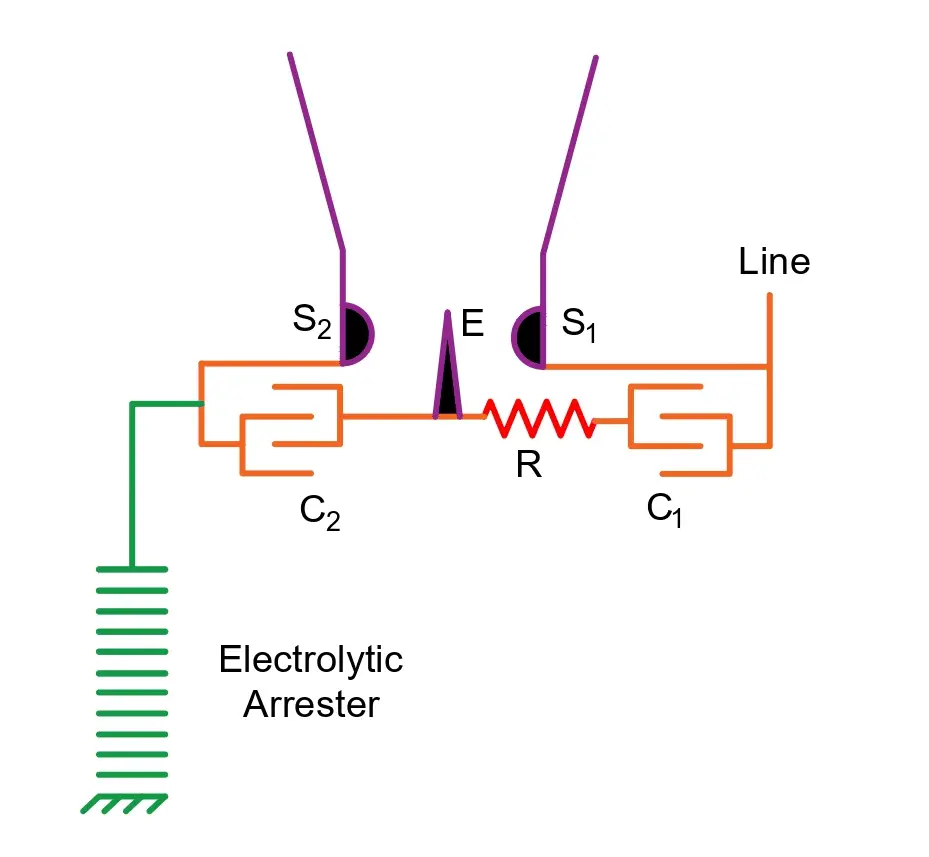
Thyrite Lightning Arrester
Such a type of arrester is most commonly used for protection against dangerous high voltage. It consists of Thyrite, an inorganic ceramic material. The resistance of such material decreases rapidly from high value to low value for high voltages during the time of a surge and provides high resistance during the time of normal operation.
Autovalve Arrester
Such types of lightning arresters consist of flat discs of a porous material stacked one above the other and separated by thin mica rings.

The disc material is a non-homogenous conducting material. Therefore the glow discharge occurs in the capillaries of the material and the voltage drop to about 350V per unit. The discs are arranged in such a way that normal voltage may not cause a discharge to occur.